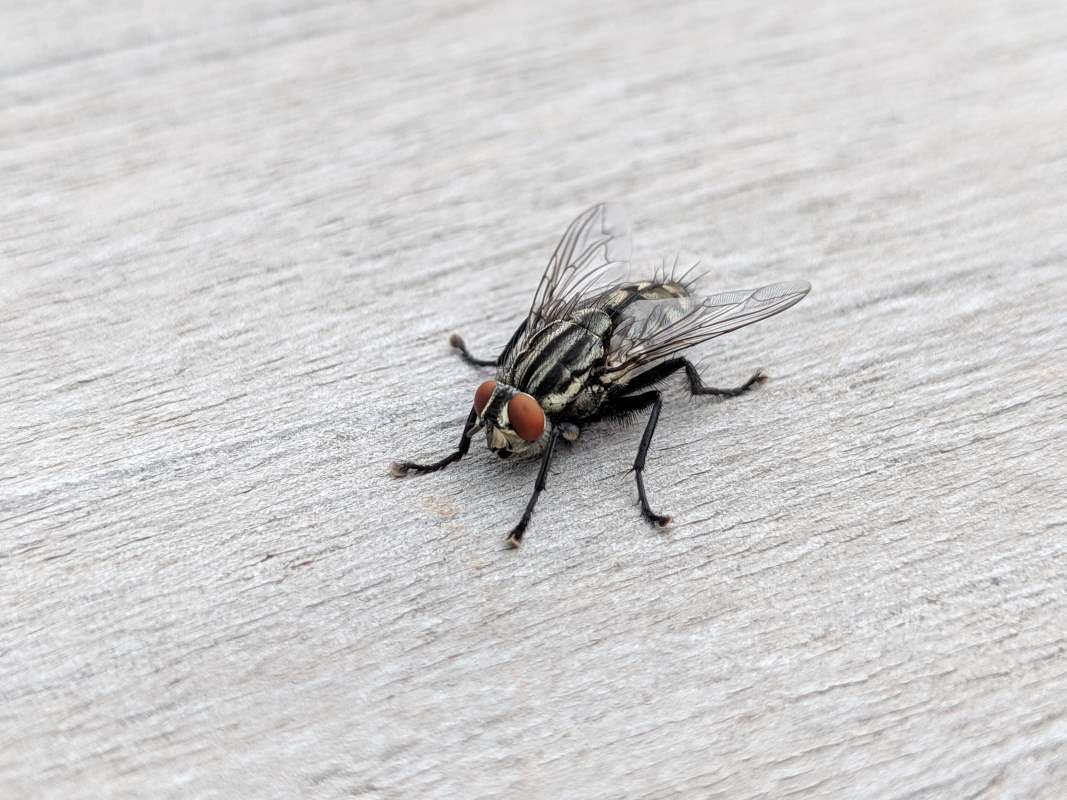
What Are Flesh Flies?
Flesh flies, or Sarcophaga crassipalpis, are an intriguing but unwelcome guest in many homes. These flies, which are notably larger than your average housefly, have a distinct diet and lifecycle that set them apart. In this blog, we’ll explore the characteristics of flesh flies, their life cycle, and the best ways to manage and prevent fly infestations.
Understanding Flesh Flies: Size, Appearance, and Behavior
Flesh flies are notably larger than houseflies, with a more robust body that often catches the eye. Typically, they are attracted to decaying flesh rather than food or waste. Their size can vary, but the initial batch of flesh flies emerging from a carcass can be quite large due to the abundant food source. Over time, as the food diminishes, the size of the flies may reduce. Flesh flies invade homes through small gaps, cracks, or open doors and windows, seeking out the smell of dead rats, mice, rodents, wildlife such as racoon, opossums, lizard, iguana, bird, or other carcasses.
Flesh Fly vs. House Fly: Key Differences
While flesh flies, drain flies, and house flies are common pests, they have distinct differences. Flesh flies are larger and prefer carrion as their food source, whereas house flies are more often attracted to trash, manure, and food. Flesh flies have a more noticeable and less uniform appearance, and a more robust build compared to the leaner house fly. Additionally, flesh flies have a highly sensitive sense of smell that helps them locate carcasses, often before homeowners even become aware of the odor.
What Do Flesh Flies Eat?
Flesh flies are scavengers, feeding primarily on decaying flesh. This diet is critical for their larvae, which feed on the carcass to grow and develop. Unlike house flies, which are attracted to a variety of waste materials, flesh flies are specifically drawn to dead animals. If there’s a carcass in or near your home, flesh flies will find it and lay their eggs, which hatch into larvae and feed voraciously on the flesh.
The Life Cycle and Habitats of Flesh Flies
The life cycle of flesh flies is quite rapid. After laying their eggs on a carcass, the eggs hatch into larvae within a day. These larvae feed on the decaying matter for about 3 to 4 days before pupating. The pupae burrow into the soil, where they mature into adult flies within 10 to 15 days. Depending on the species and local climate, this cycle can be completed in as little as one to two weeks. In temperate climates, flesh flies often overwinter in their pupal stage and emerge in the spring to start the cycle anew.
Health Risks Associated with Flesh Flies
Flesh flies and house flies can pose several health risks. They are known to transport disease-causing organisms due to their diet and the environments they frequent. The presence of these flies can also indicate underlying sanitation issues, as their primary food source is carcasses. This can give evidence of a possible rodent infestation or other pests causing an unhygienic environment. Effective management and prevention of flies and rodents is crucial to maintaining a healthy home.
Find Professional Fly Control with Hulett Environmental Services Near West Palm Beach
If you’re dealing with a flesh fly infestation or want to prevent one, the best approach is to control the current infestation with baits and traps, and then ensure your home stays rodent-free in the future, and Hulett Environmental Services is here to help. Our team, backed by over 50 years of experience and a commitment to eco-friendly pest control, can provide a thorough inspection and a customized treatment plan. We utilize the latest technology and techniques to ensure effective and long-lasting results.
Contact Hulett Environmental Services for a free, no-obligation inspection to address your pest control needs. Whether you’re in West Palm Beach or the surrounding areas in Palm Beach County and the Treasure Coast, our expert technicians are ready to help you achieve a fly-free environment.



